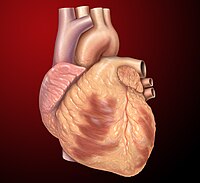
Photo from wikipedia
Objective This study aimed to develop and validate models using radiomics features on a native T1 map from cardiac magnetic resonance (CMR) to predict left ventricular reverse remodeling (LVRR) in… Click to show full abstract
Objective This study aimed to develop and validate models using radiomics features on a native T1 map from cardiac magnetic resonance (CMR) to predict left ventricular reverse remodeling (LVRR) in patients with nonischemic dilated cardiomyopathy (NIDCM). Materials and Methods Data from 274 patients with NIDCM who underwent CMR imaging with T1 mapping at Severance Hospital between April 2012 and December 2018 were retrospectively reviewed. Radiomic features were extracted from the native T1 maps. LVRR was determined using echocardiography performed ≥ 180 days after the CMR. The radiomics score was generated using the least absolute shrinkage and selection operator logistic regression models. Clinical, clinical + late gadolinium enhancement (LGE), clinical + radiomics, and clinical + LGE + radiomics models were built using a logistic regression method to predict LVRR. For internal validation of the result, bootstrap validation with 1000 resampling iterations was performed, and the optimism-corrected area under the receiver operating characteristic curve (AUC) with 95% confidence interval (CI) was computed. Model performance was compared using AUC with the DeLong test and bootstrap. Results Among 274 patients, 123 (44.9%) were classified as LVRR-positive and 151 (55.1%) as LVRR-negative. The optimism-corrected AUC of the radiomics model in internal validation with bootstrapping was 0.753 (95% CI, 0.698–0.813). The clinical + radiomics model revealed a higher optimism-corrected AUC than that of the clinical + LGE model (0.794 vs. 0.716; difference, 0.078 [99% CI, 0.003–0.151]). The clinical + LGE + radiomics model significantly improved the prediction of LVRR compared with the clinical + LGE model (optimism-corrected AUC of 0.811 vs. 0.716; difference, 0.095 [99% CI, 0.022–0.139]). Conclusion The radiomic characteristics extracted from a non-enhanced T1 map may improve the prediction of LVRR and offer added value over traditional LGE in patients with NIDCM. Additional external validation research is required.
Journal Title: Korean Journal of Radiology
Year Published: 2023
Link to full text (if available)
Share on Social Media: Sign Up to like & get
recommendations!